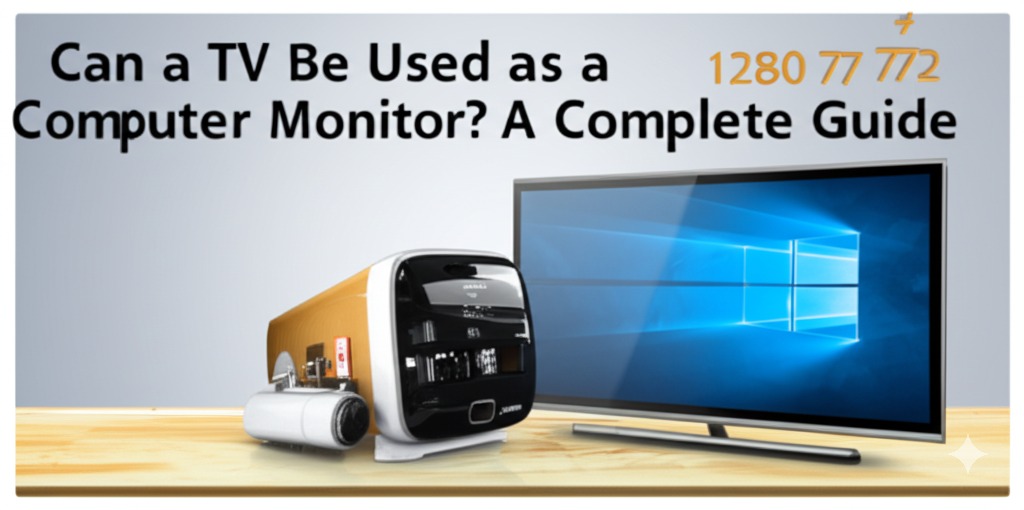Ever found yourself staring at your big-screen TV and wondering, “Can I just use that as my computer monitor?” You’re not alone—and yes, using a TV as a computer monitor is absolutely possible. But like most things tech-related, there are pros, cons, and a few technical details to understand first.
In this article, we’ll walk you through everything you need to know: how it works, what you’ll need, the benefits, potential downsides, and how to set it up the right way.
Why Use a TV as a Computer Monitor?
Big Screen, Big Appeal
One of the most obvious reasons to use a TV as a monitor is screen size. TVs offer a much larger display compared to traditional monitors, making them great for:
- Watching videos or movies
- Gaming on a bigger screen
- Multitasking with multiple windows open
- Presenting or sharing content in group settings
Budget-Friendly Option
Already have a spare TV? Then using it as a computer monitor is a cost-effective solution, especially if you’re trying to avoid spending extra money on a new monitor.
How to Connect a TV to a Computer
HDMI: The Standard Connection
Most modern TVs and computers come equipped with HDMI ports, which makes connecting the two super easy.
Steps to Connect via HDMI:
- Plug one end of the HDMI cable into your computer’s HDMI output.
- Plug the other end into your TV’s HDMI input.
- Use your TV remote to switch to the correct HDMI input source.
- Your computer should automatically detect the TV as a display.
Tip: If you’re using a desktop PC, make sure your graphics card supports HDMI or DisplayPort to HDMI output.
Wireless Options (Screen Mirroring)
For casual use like streaming or browsing, wireless screen mirroring can be a convenient alternative.
- Windows users can use Miracast.
- Mac users can connect via AirPlay (on compatible smart TVs).
- Devices like Chromecast, Apple TV, or Amazon Fire Stick also support wireless connections.
What to Consider Before Using a TV as a Monitor
1. Input Lag
TVs are designed for watching content—not for interactivity. That means they often have higher input lag, which causes a delay between your keyboard/mouse actions and what you see on the screen.
Gamers and graphic designers, take note: Input lag can significantly affect performance.
Solution: Look for a TV with a “Game Mode” setting to reduce lag.
2. Resolution and Scaling
Most TVs today are 1080p or 4K, which sounds great—but pixel density matters more than just resolution. A 40-inch 1080p TV will look much less crisp up close compared to a 24-inch 1080p monitor.
Text might appear blurry or oversized unless you adjust your display scaling settings.
3. Refresh Rate
Standard TVs usually have a 60Hz refresh rate, which is fine for general use but might feel choppy during fast-paced gaming or video editing.
Higher refresh rate TVs (120Hz or more) offer smoother visuals but are often more expensive.
4. Color Accuracy
TVs tend to enhance contrast and saturation for visual punch, which can lead to less accurate color reproduction.
If you’re working with photography, video editing, or design, a calibrated computer monitor is still your best bet.
Ideal Scenarios for Using a TV as a Monitor
Using a TV as a monitor can work really well in certain scenarios:
- Media consumption: Perfect for streaming Netflix, YouTube, or watching movies.
- General productivity: Great for spreadsheets, web browsing, and multitasking with lots of screen space.
- Console and casual PC gaming: Especially if your TV supports low-lag game modes.
- Presentations or shared screens: When collaborating or displaying content in a meeting room or home office.
Best Practices for Using a TV as a Computer Monitor
Here’s how to get the best experience:
- Use a 4K TV if you want crisp text and visuals.
- Sit at least 3 feet away to avoid eye strain from large screens.
- Adjust scaling settings in Windows/macOS to optimize readability.
- Enable Game Mode to reduce input lag.
- Check your refresh rate settings in display options.
- Use a high-quality HDMI cable (especially for 4K output).
Conclusion: Should You Use a TV as a Monitor?
Yes, you can use a TV as a computer monitor—and in many cases, it works quite well! Just keep in mind the differences in performance, resolution, and input lag compared to standard monitors.
If you’re doing media consumption, casual gaming, or office tasks, a TV might be a great choice. For color-critical work or fast-paced gaming, you may still prefer a dedicated monitor.
Want to try it? Grab an HDMI cable and connect your TV today—just don’t forget to fine-tune your settings for the best experience!

Caleb Carlson is a contributing writer at Computer Site Engineering, specializing in computer technology, software trends, and hardware innovations. His articles simplify complex tech topics, making them accessible to readers of all levels.





